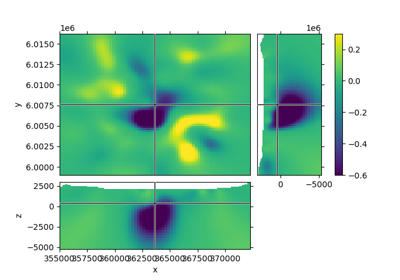discretize.mixins.Slicer#

- class discretize.mixins.Slicer(mesh, v, xslice=None, yslice=None, zslice=None, v_type='CC', view='real', axis='xy', transparent=None, clim=None, xlim=None, ylim=None, zlim=None, aspect='auto', grid=(2, 2, 1), pcolor_opts=None, **kwargs)[source]#
Plot slices of a 3D volume, interactively (scroll wheel).
If called from a notebook, make sure to set
%matplotlib notebook
- Parameters:
- v(
n_cells)numpy.ndarray Data array
- xslice, yslice, zslice
float,optional Initial slice locations (in meter); defaults to the middle of the volume.
- v_type: {‘CC’, ‘Fx’, ‘Fy’, ‘Fz’, ‘Ex’, ‘Ey’, ‘Ez’}
Type of visualization.
- view{‘real’, ‘imag’, ‘abs’}
Which component to show.
- axis{‘xy’, ‘yx’}
‘xy’: horizontal axis is x, vertical axis is y. Reversed otherwise.
- transparent‘slider’ or
listoffloatorpairsoffloat,optional Values to be removed. E.g. air, water. If single value, only exact matches are removed. Pairs are treated as ranges. E.g. [0.3, [1, 4], [-np.infty, -10]] removes all values equal to 0.3, all values between 1 and 4, and all values smaller than -10. If ‘slider’ is provided it will plot an interactive slider to choose the shown range.
- clim
Noneorlistof[min,max] For pcolormesh (vmin, vmax). Note: if you use a norm (e.g., LogNorm) then vmin/vmax have to be provided in the norm.
- xlim, ylim, zlim
Noneorlistof[min,max] Axis limits.
- aspect‘auto’, ‘equal’,
ornum Aspect ratio of subplots. Defaults to ‘auto’.
A list of two values can be provided. The first will be for the XY-plot, the second for the XZ- and YZ-plots, e.g. [‘equal’, 2] to have the vertical dimension exaggerated by a factor of 2.
- WARNING: For anything else than ‘auto’, unexpected things might happen
when zooming, and the subplot-arrangement won’t look pretty.
- grid(3)
listofint Number of cells occupied by x, y, and z dimension on plt.subplot2grid.
- pcolor_opts
dictionary Passed to pcolormesh.
- v(
Methods
onscroll(event)Update index and data when scrolling.
Update plot for change in Z-index.
Update plot for change in Y-index.
Update plot for change in X-index.
Examples
The straight forward usage for the Slicer is through, e.g., a TensorMesh-mesh, by accessing its mesh.plot_3d_slicer.
If you, however, call this class directly, you have first to initiate a figure, and afterwards connect it:
>>> fig = plt.figure()
Then you have to get the tracker from the Slicer
>>> tracker = discretize.View.Slicer(mesh, Lpout)
Finally you have to connect the tracker to the figure
>>> fig.canvas.mpl_connect('scroll_event', tracker.onscroll) >>> plt.show()

